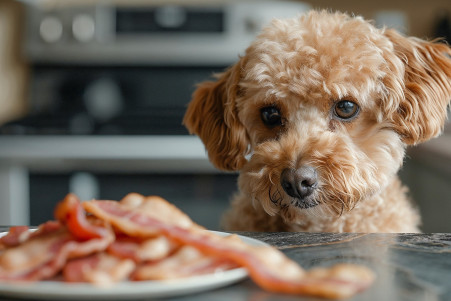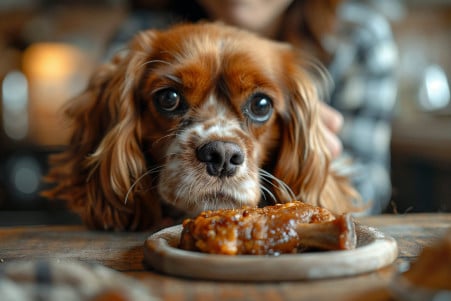Can Dogs Have Raw Pork? The Dangers and Healthy Options
14 May 2024 • Updated 13 May 2024

If you've ever looked at a raw pork chop and then at your dog and wondered if you could give them a piece, you're not alone. However, the answer to this question is a bit more complicated than you may realize. While dogs can have raw pork, the dangers of trichinosis and bacterial infections make it too risky, so it's best to avoid giving your dog any raw or undercooked pork products to ensure their safety.
To help you better understand why raw pork is so dangerous for dogs and what you can do to make sure you're protecting them, we've looked at scientific evidence from veterinary professionals, microbiology research on foodborne diseases, and information on the nutritional requirements of dogs. This will help you make sure you're aware of the potential risks while still enabling you to give your dog pork-based treats from time to time in a way that's safe and healthy for them.
Can dogs eat raw pork?
What Is Trichinosis? A Parasitic Infection From Eating Raw Pork
Trichinosis is caused by the Trichinella spiralis roundworm, also known as the 'pork worm', which can infect both humans and animals. According to the CDC, infection occurs when undercooked meat containing the larvae is consumed, allowing the worms to mature in the intestine and then encyst in muscle tissue.
Proper cooking of pork to an internal temperature of at least 145°F (63°C) for roasts and 160°F (71°C) for ground meats is necessary to kill the parasite. While freezing pork at specific temperatures like -22°F (-30°C) for 6 days can help eliminate the risk, cooking remains the safest method to prevent trichinosis.
While trichinosis is generally asymptomatic in animals, it poses a significant public health risk and prevention through proper meat handling is crucial, especially when feeding dogs. By understanding the parasite's life cycle and taking the recommended precautions, pet owners can protect both their dogs and themselves from this preventable infection. Avoiding raw or undercooked pork is advisable, but there are other potential meat sources that carry trichinosis risks as well.
Other Meats and Trichinosis Risk
Although pork is the most common source of trichinosis, the parasite can also be found in wild game meats such as bear and feral hogs. The CDC reports that cases of trichinosis from wild game have been on the rise in recent years, emphasizing the importance of ensuring these meats are cooked thoroughly. Smoking, curing, or freezing meat alone may not be enough to kill the Trichinella parasite, as the Merck Veterinary Manual explains, so it's important to make sure the meat is cooked to a safe temperature.
In general, when it comes to dogs, it's best to avoid raw meats and instead stick to cooked, lean protein sources such as chicken, turkey, or beef. Dogs Naturally Magazine explains that regardless of the type of meat, it's important to handle and cook all meat products properly to avoid potential parasitic infections in both dogs and humans. By knowing the risks associated with meats other than pork, dog owners can make sure they're making informed decisions that prioritize their dog's health and well-being.
How to Treat Trichinosis in Dogs: Signs and Medication
Initial signs of trichinosis in dogs can include gastrointestinal symptoms like vomiting, diarrhea, and abdominal pain. According to WagWalking, once the larvae move to the muscles, dogs can also experience fever, lethargy, muscle pain, and swelling around the eyes or other parts of the body.
In severe cases, complications like heart or respiratory failure can occur, and dogs may need to be hospitalized and treated with intravenous (IV) medications. The Mayo Clinic states that trichinosis is usually diagnosed with a fecal test or muscle biopsy, and treated with anti-parasitic medications like mebendazole or ivermectin for a few weeks.
It’s important to catch and treat trichinosis early, as the Merck Veterinary Manual says that once the larvae have encysted in the muscles, there’s no treatment that’s been proven to be effective. By learning to recognize the signs and getting your dog to the vet as soon as possible, you can help prevent your pet from suffering from the serious consequences of this parasitic disease.
Other Safe Protein Options for Dogs: Are There Any Other Alternatives to Raw Pork?
Cooked chicken, beef, turkey, and fish (especially salmon) are all safe protein options for dogs and can be used in their diet. Per PetMD, chicken, turkey, and beef are the best proteins to use in raw food diets because dogs "thrive on" them. Other lean meats like lamb, venison, duck, and rabbit can also be given to dogs, as long as they are cooked through and come from a reputable source.
Insect proteins (crickets, grubs) are becoming more popular as sustainable, nutrient-dense, and hypoallergenic protein options for dogs. Per Jiminy's, crickets and grubs are complete proteins that have a lower environmental impact than traditional animal proteins.
Pork should be cooked thoroughly before being given to dogs, and only lean cuts that are low in fat and salt should be used. Per Dog Child, raw pork can be risky for dogs because it can contain pathogens, but cooked pork is safe in moderation. Dogs should have a balanced diet that includes a variety of protein sources, and no one ingredient should be given to them in excess.
Conclusion: Make Sure You're Prioritizing Your Dog's Health and Safety
If you're a dog owner, you may have found yourself asking if it's OK to give your dog a piece of raw pork. However, the answer to this question is a bit more complicated than you might think. Although dogs can eat raw pork, there are many health risks associated with it, including trichinosis and bacterial infections, so it's best to steer clear of feeding your dog any raw or undercooked pork products to ensure their health and safety.
Trichinosis is a parasitic disease caused by the Trichinella spiralis roundworm, which is often referred to as the 'pork worm' because it can be found in pork products. It can infect both humans and animals, and it occurs when the larvae are ingested in undercooked meat. The larvae then mature in the intestines and form cysts in the muscle tissue. To kill the parasite, pork must be cooked to an internal temperature of at least 145°F (63°C) for roasts and 160°F (71°C) for ground meats.
Although pork is the most common source of trichinosis, the parasite can also be found in wild game meats, such as bear and feral hogs. The CDC reports that trichinosis cases from wild game have been on the rise in recent years, which emphasizes the importance of cooking these meats thoroughly. When it comes to dogs, it's generally best to avoid raw meat and stick to cooked, lean protein sources, such as chicken, turkey, or beef.
Initial symptoms of trichinosis in dogs may include gastrointestinal issues like vomiting, diarrhea, and abdominal pain. WagWalking explains that as the larvae move to the muscle tissue, dogs may experience fever, fatigue, muscle pain, and swelling around the eyes or other parts of the body. It's important to catch this disease early and seek treatment because the Merck Veterinary Manual explains that once the larvae have formed cysts in the muscles, there's no effective treatment.
Dogs can eat cooked chicken, beef, turkey, and fish, such as salmon. Jiminy's also points out that insects, such as crickets and grubs, are becoming increasingly popular as sustainable, nutrient-dense, and hypoallergenic protein sources for dogs. If you do feed your dog pork, make sure it's cooked thoroughly, and stick to lean cuts that are low in fat and salt.
If you're unsure about the best diet or protein sources for your dog, especially if they have specific dietary needs, it's best to seek advice from a veterinarian or a reputable pet nutritionist.


